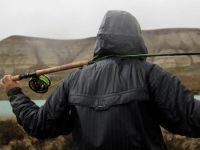From: 04/02/2014
To: 04/02/2014
Type of Water: Freshwater
Species: Steelhead
SANTA CRUZ STEELHEAD UNRIDDLED
*Notes on how to prepare for the most unique river in Patagonia, by Claudio Martin.
The weather during fall is usually calm with a lack of strong wind (most common during Spring) and slightly cool. Its mid morning in one of those days fishing with friends when we make it to the first pool. Line is pulled out of the reel for the very first cast of the day, rolled it and let go… it swings slowly as the fly sinks and swims across this mean large eddy when a huge colored male hits it hard and immediately shows in the air!
Considered by many the ultimate Steelhead challenge, fishing for Steelhead in the mighty Santa Cruz River is every time a soul touching experience. The river has a still unknown number of fish running up river e View more... SANTA CRUZ STEELHEAD UNRIDDLED
*Notes on how to prepare for the most unique river in Patagonia, by Claudio Martin.
The weather during fall is usually calm with a lack of strong wind (most common during Spring) and slightly cool. Its mid morning in one of those days fishing with friends when we make it to the first pool. Line is pulled out of the reel for the very first cast of the day, rolled it and let go… it swings slowly as the fly sinks and swims across this mean large eddy when a huge colored male hits it hard and immediately shows in the air!
Considered by many the ultimate Steelhead challenge, fishing for Steelhead in the mighty Santa Cruz River is every time a soul touching experience. The river has a still unknown number of fish running up river every year in search of the perfect water to lay and eventually spawn.
The main run gets in the system by late February and shows up in Los Plateados area by mid March, over 50 miles from the estuary. This particular stretch provides of a unique structure that works as the ideal holding water for them.
Even thou this river discourages anglers -mainly because of its size and maybe for the weather conditions- catching an Atlantic Steelhead is not mission impossible. Steelhead fishing demands commitment, yes. Its about covering water and swinging flies in those places you know there’s gotta be a fish waiting, resting… It’s a little bit of faith too… I agree. The truth is that the Steelhead population in this river is large, large enough to find fish every time you try a spot like that. Such statement demands proof and there is more than one. Figures of the last three years on that specific area show that an average angler can make a dream come true and hook more than one fish a day… and in some cases many more.
When trying to figure this river out, the first “wall” can be the size of it. Steelhead use the whole of the river to run upstream, but lets face it, its easier closer to the banks… a secret they know! Considering that when fishing you do what makes more sense. Wading less and focusing more in covering the closer water seem to be a way to get the results. Also paying more attention in what the fly is doing, its depth, the speed and the way to mend the line, etc. than shooting line for the only reason of having a good setup (or the wind behind of course).
When studying the fish behavior it clearly shows that these fish are extremely territorial. Steelhead reaction to noise in the water, firstly, will be getting even more aggressive. Not talking about using the “Jim Teeny” technique and throw stones to the water, but to use that for your benefit. For that purpose larger flies will help -they also cover more water-, and even more when the fall comes with colder temperatures, just like any other Steelhead river in the world.
Tackling up for a Santa Cruz trip demands a few things, nothing that far from the normal nowadays: Regarding lines, a Skagit head with a set of tips will work for most of the water, even though a Fast Sink Shooting Head (Scandinavian style) will help in the narrower faster channels where sinking your line really fast and keeping it down makes a difference. I normally carry a 9wt Double handed rod (13’8’’ in this case) with my Skagit line and an 12’6’’ 8wt with the Type 6/7 Sinking head. A double set up with a Float Skagit head in one and an Intermediate head in the other will work too if Scandi style is not your thing. Consider the double set up as it will make you save quite a lot of time when trying to figure or learn new water.
When talking about rods its generally suggested to have a faster action one mainly to manage the weather and keep control when the wind comes. If the Skagit set up is fine tuned you may have no problem going with a softer/slower action rod. Then it goes into the different choices/preferences of each angler.
Flies as said before can work in a wide range and variety of sizes and colors. From the traditional patterns like a Freight Train or a Skunk to the favorites of many, the articulated leeches, Intruders, etc, in as many colors as you wish, having Steelhead a thing for the blue, light blue, up to purple colors and combinations. Orange has been the locals favorite for years and works as well. Again, the fly is important, but the swing in the key.
Preparation for the Santa Cruz may take some effort but there’s no preparation whatsoever for the impact it will have in your heart and soul. Prepare to be hunted by this water.
















